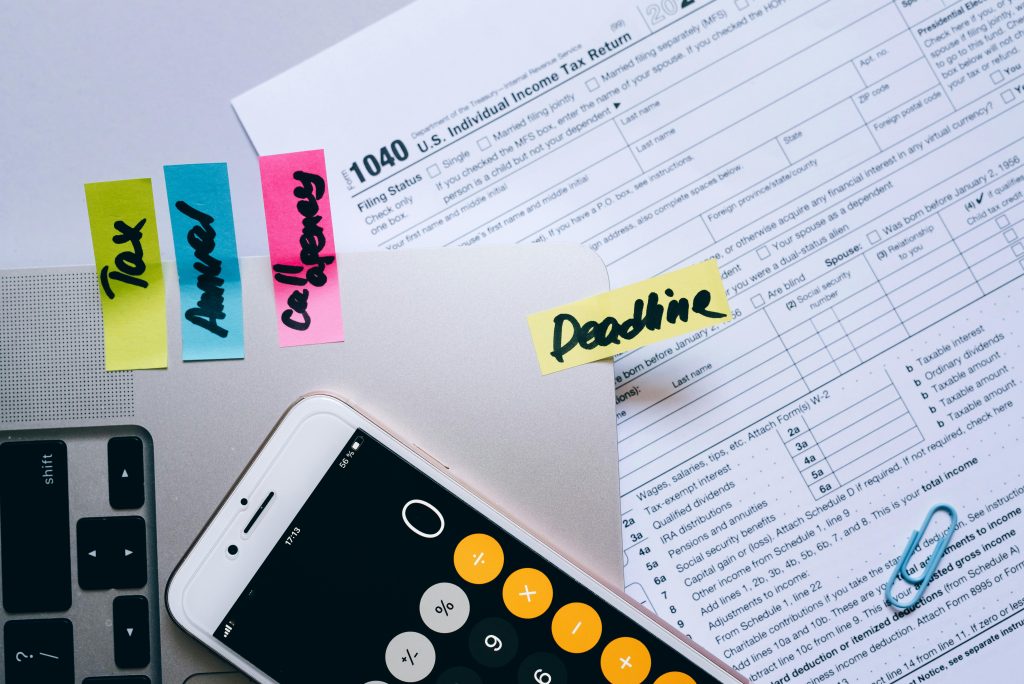Tax season can feel like a leap into the unknown. One moment, you’re managing monthly expenses. Next, you face a lump-sum payment that strains your cash flow. Learning how to budget and apply budget planning to your annual tax bill can help you avoid penalties, high-interest debt, or dipping into emergency savings.
Mastering budgeting bills makes tax season more predictable.
In this guide, you will learn how to:
- Estimate what you owe before deadlines arrive
- Build a dedicated tax savings plan using proven budget planning methods and learn how to make a budget for your tax bill
- Use tax-advantaged accounts as part of your tax planning strategies
- Claim the right credits and deductions to learn how to reduce your tax
- Monitor and adjust your strategy throughout the year with budget tips and tax optimization strategies
Whether you have a steady paycheck, freelance income, or multiple revenue streams, this guide offers a step-by-step approach to how to budget money for your tax bill.
Combine budget planning with tax planning strategies to stay on track and avoid penalties.
Next up, we’ll explore why budgeting for your tax bill matters and how small shortfalls can lead to big headaches.
Why Budgeting for Your Tax Bill Matters
Risks of Under-Saving
Small shortfalls in your tax reserve can trigger underpayment penalties or push you to tap high-interest credit when tax time arrives. For self-employed or gig workers, irregular income makes surprise tax bills harder to cover. This can strain cash flow and impact your credit score. These risks highlight why budget planning for your annual tax bill matters.
Benefits of a Dedicated Tax Savings Plan
Creating a separate account just for taxes helps you track and protect funds from everyday spending. Automate transfers each payday to steadily build your reserve. Use this method as part of your overall budget planning and how to make a budget approach:
- Allocate 20% of after-tax income under a 50/30/20 budget framework
- Use zero-based budgeting to assign a purpose to every dollar
- Maintain distinct buckets for emergencies, retirement, and taxes
These budget tips help prevent penalties, protect cash flow, and may earn interest until you file.
Calculate Your Estimated Tax Liability

Estimating your annual tax bill gives you a clear savings target. It anchors your plan for budgeting bills. Applying how to budget money principles, you can set realistic goals that help you meet IRS deadlines.
Review Previous Tax Returns
Start with last year’s Form 1040 and schedules. Note your adjusted gross income, taxable income, total tax, deductions, and credits. Use these figures as a baseline for your budget planning. If your filing status or number of dependents changed, adjust your estimates accordingly.
Project This Year’s Income
Combine all expected income sources to refine your budget:
- Salary and bonuses
- Freelance or self-employment earnings
- Dividends, interest, and capital gains
- Rental and other miscellaneous income
Estimate changes from last year, such as raises or new revenue streams. After listing your income, subtract anticipated deductions and credits to calculate your projected taxable income.
Use an Online Tax Estimator
Use an online tax estimator within your budget planning process. Tools like these provide budget tips on quarterly savings:
- IRS Tax Withholding Estimator or the Form 1040-ES worksheet on IRS.gov
- TurboTax online estimator
- ProConnect
Enter your projected income, deductions, and credits to get an estimated tax liability. These tools often break down quarterly estimated payments and list due dates, such as April 15, June 15, September 15, and January 15. Revisit and recalculate each quarter if your income shifts to stay on track and avoid underpayment penalties.
Set Up a Tax Savings Plan
Establishing a clear savings plan is a core tax planning strategy and part of budget planning. Focus on three key steps, automating transfers, choosing the right account, and adjusting payroll withholding, to keep your reserve on track.
Automate Savings Transfers
Automated transfers help you follow your budget tips without manual effort. Link your checking account to a savings or money market account and set up transfers each payday. If your income varies, schedule reminders to top off your tax reserve when deposits are skipped. Many banks and budgeting apps let you customize transfer amounts based on your income schedule.
Open a Dedicated Tax Savings Account
Segregate tax funds from everyday savings to avoid accidental spending. Choose a high-yield FDIC-insured account with competitive interest rates.
Some banks let you create multiple “buckets” within one account, assigning one exclusively to tax obligations. Interest earnings stay in that bucket, helping your reserve grow faster.
Adjust Your W-4 Withholdings
Federal taxes operate on a pay-as-you-go basis. If your withholding falls short, you may face underpayment penalties.
Use the IRS Withholding Estimator to calculate your allowances for the current year. Then submit an updated Form W-4 to your employer to align payroll deductions with your projected liability.
When to Review Your Withholding
Review your W-4 after major life events, such as marriage, a new job, or significant income changes. A quarterly check lets you fine-tune withholding and avoid surprises at tax time.
By automating savings, keeping funds in a dedicated account, and adjusting withholding with your projected bill, you build a reliable tax savings plan. These tax planning strategies and budget planning tips help you avoid penalties, protect cash flow, and gain confidence heading into filing season.
Leverage Tax-Advantaged Accounts
Tax-advantaged accounts lower your taxable income and support long-term savings goals.
By directing funds into these vehicles, you benefit from deferred or tax-free growth and may gain state-level deductions. These tax planning strategies help reduce your tax bill. Focus on three key account types to maximize your tax advantage.
Maximize Retirement Contributions (401(k) & IRA)
Tax-Deferred vs Tax-Exempt Accounts
Traditional 401(k) and IRA contributions use pre-tax dollars to reduce your current-year taxable income. Investments grow tax-deferred and distributions in retirement are taxed as ordinary income. Roth options require after-tax contributions but offer tax-free withdrawals on qualified distributions. These are core tax planning strategies that fit into your budget planning.
Contribution Strategies
- Aim to contribute at least enough each pay period to capture your full employer match.
- For 2024, individuals under age 50 may contribute up to $7,000 to IRAs; those 50 and older can add $8,000 in catch-up contributions.
- Spread contributions evenly throughout the year to maintain consistent tax benefits and steady savings.
- Review your plan’s vesting schedule to secure employer contributions as soon as possible.
Use FSAs and HSAs for Medical Expenses
Flexible Spending Accounts (FSAs) and Health Savings Accounts (HSAs) provide targeted tax relief on health costs. FSAs let you set aside pre-tax dollars for eligible expenses, lowering your taxable income. Note that unused funds typically expire at year end.
HSAs require enrollment in a high-deductible health plan and offer a triple-tax advantage:
- Contributions reduce your adjusted gross income and help with budgeting bills.
- Account balances grow tax-free when invested.
- Qualified withdrawals for medical expenses incur no tax.
If you leave funds invested, an HSA can double as a supplemental retirement account. After age 65, non-medical withdrawals are taxed at ordinary rates without penalty.
529 Plans for Education Savings
529 college savings plans allow contributions to grow with federal tax-free compounding. Qualified withdrawals for tuition, fees, and other approved education costs incur no federal tax. Many states also offer an income-tax deduction or credit for contributions. These plans offer a tax optimization strategy for families.
You can change beneficiaries to another family member if needs change. Some 529 plans now cover K-12 tuition and up to $10,000 in student loan repayments per beneficiary.
By fully funding these accounts, you align your budget planning, tax planning, and education goals. Regular contributions build a tax-efficient savings foundation and help reduce your tax liability.
Reduce Your Tax Bill with Credits and Deductions

Claim Available Tax Credits
Tax credits reduce your tax liability dollar-for-dollar and can even boost your refund. If you want to learn how to reduce your tax, claiming the right credits is one of the best approaches. These credits are a core part of tax planning strategies.
Key credits include:
- Earned Income Tax Credit (EITC) for low- to moderate-income workers.
- Child Tax Credit and Child and Dependent Care Credit.
- Education credits (American Opportunity and Lifetime Learning) and the Saver’s Credit.
- Adoption credit, clean energy credits, and the Premium Tax Credit for marketplace health plans.
Review eligibility criteria on IRS.gov to confirm you qualify. Then file forms like Schedule EIC for the Earned Income Tax Credit and Form 2441 for the Child and Dependent Care Credit.
Optimize Itemized Deductions
Itemize when deductions exceed the standard amounts (2024: $14,600 single; $29,200 married filing jointly). This step supports budget planning and can reduce your tax liability.
Charitable Giving
Deduct cash and property gifts with written receipts. The IRS caps cash contributions at 60% of AGI.
Medical Expenses
Claim unreimbursed medical and dental costs that exceed 7.5% of AGI. Include prescriptions and mileage at the IRS rate.
State and Local Taxes
Deduct up to $10,000 for combined state and local income, sales, and property taxes. Keep tax bills and statements for documentation.
Harvest Capital Losses
Offset gains by selling underperforming investments in your taxable account. Net losses up to $3,000 reduce ordinary income annually. Carry forward excess losses indefinitely.
Avoid wash-sale rule violations by waiting at least 31 days before repurchasing the same security. Review your portfolio late in the year to spot loss harvesting opportunities. Consult a tax advisor to confirm compliance with IRS rules.
Monitor and Adjust Throughout the Year
Adjusting your plan ensures steady progress in your budget planning and prevents surprises.
Schedule Regular Check-Ins
Schedule quarterly budget reviews as a key budget tip. Set calendar reminders to compare actual income and expenses against your projections. Adjust your savings targets if you receive a raise or incur new costs.
Use Apps and Templates
Use apps and templates to simplify how to make a budget. Tools like the NerdWallet budget template or Bank of America’s Spending & Budgeting tool help track transactions, categorize spending, and monitor progress on mobile.
Update Estimates Promptly
When earnings or expenses shift, recalculate your annual tax liability. Automate transfers to align contributions with your updated budget targets and avoid surprises at filing time.
Conclusion
Budgeting for your annual tax bill turns a stressful task into a regular part of your budget planning. By following these budget tips and tax planning strategies, you can build a reliable plan that protects cash flow, minimizes penalties, and even boosts savings.
Key takeaways:
- Estimate Your Liability
Review last year’s returns, project income, and use online estimators to set a clear savings target. - Create a Tax Savings Plan
Automate transfers, open a dedicated account, and adjust your W-4 withholding to match your projected tax obligation. - Leverage Tax-Advantaged Accounts
Max out retirement plans, FSAs, HSAs, and 529 savings to reduce taxable income and support long-term goals. - Claim Credits and Deductions
Identify all eligible credits, optimize itemized deductions, and consider year-end loss harvesting to lower your final bill. - Monitor and Adjust
Schedule quarterly check-ins, use budgeting apps or templates, and update your estimates after income changes.
Putting these budget tips into practice gives you control over your tax outcome. You’ll replace last-minute scrambles with confidence, knowing you’ve set aside the right funds and used every available tax break to reduce your tax liability.
Take the first step today: review your current balances, adjust your plan, and let automated transfers build your reserve. With consistent effort and the strategies outlined here, tax season becomes a predictable checkpoint rather than a financial hurdle. Stay proactive, stay informed, and let your budgeting work for you.




















